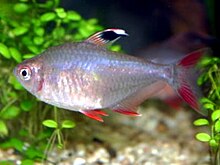Characiformes
| Characiformes Temporal range: [1] | |
|---|---|
 | |
| Hyphessobrycon bentosi | |
| Scientific classification | |
| Domain: | Eukaryota |
| Kingdom: | Animalia |
| Phylum: | Chordata |
| Class: | Actinopterygii |
| (unranked): | Otophysi |
| Order: | Characiformes Regan, 1911 |
| Type species | |
| Charax gibbosus | |
| Families | |
| |
Characiformes /ˈkærəsɪfɔːrmiːz/ is an order of ray-finned fish, comprising the characins and their allies. Grouped in 18 recognized families, more than 2000 different species are described, including the well-known piranha and tetras.[1]
Taxonomy[edit]
The Characiformes form part of a series called the Otophysi within the superorder Ostariophysi. The Otophysi contain three other orders, Cypriniformes, Siluriformes, and Gymnotiformes.[1] The Characiformes form a group known as the Characiphysi with the Siluriformes and Gymnotiformes.[2] The order Characiformes is the sister group to the orders Siluriformes and Gymnotiformes, though this has been debated in light of recent molecular evidence.[1]
Originally, the characins were all grouped within a single family, the Characidae. Since then, and also 18 different families have been separated out. However, classification varies somewhat, and the most recent (2011) study confirms the circumscribed Characidae as monophyletic.[3] Currently, 18 families, about 270 genera, and at least 1674 species are known.[3] The suborder Citharinoidei, which contains the families Distichodontidae and Citharinidae, is considered the sister group to the rest of the characins, suborder Characoidei.[2]
Evolution[edit]
The oldest characiform is Santanichthys of the Early Cretaceous (Albian Age) of Brazil. All extant species live in fresh water, but this Cretaceous species probably lived in either brackish or marine water. Many other fossils are also known.[1] The Characiformes likely first diversified during the Cretaceous Period, though fossils are poorly known.[1] During the Cretaceous Period, the rift between South America and Africa would be forming; this may explain the contrast in diversity between the two continents. Their low diversity in Africa may explain why some primitive fish families and the Cypriniformes coexist with them whereas they are absent in South America, where these fish may have been driven extinct.[2] The characiforms had not spread into Africa soon enough to also reach the land connection between Africa and Asia.[2] The earliest they could have spread into Central America was the late Miocene.[2]
Phylogeny[edit]
Below is a phylogeny of living Characiformes based on Betancur-Rodriguez et al. 2017[4] and Nelson, Grande & Wilson 2016.[5]
| Characiformes |
| ||||||||||||||||||||||||||||||||||||||||||||||||||||||||||||||||||||||||||||||||||||||||||||||||||||||||||||||||||||||||||||||||||||||||||
Description[edit]
Characins possess a Weberian apparatus, a series of bony parts connecting the swim bladder and inner ear.[1] Superficially, the Characiformes somewhat resemble their relatives of the order Cypriniformes, but have a small, fleshy adipose fin between the dorsal fin and tail. Most species have teeth within the mouth, since they are often carnivorous. The body is almost always covered in well-defined scales. The mouth is also usually not truly protractile.[6]
The largest characins are Hydrocynus goliath and Salminus franciscanus and Hoplias aimara,[7] both of which are up to 1.2 m (3.9 ft). The smallest in size is about 1.7 cm (0.67 in) in the Bolivian pygmy blue characin, Xenurobrycon polyancistrus.[8] Many members are under 3 cm (1.2 in).[1]
Distribution and habitat[edit]
Characins are most diverse in the Neotropics, where they are found in lakes and rivers throughout most of South and Central America. The red-bellied piranha, a member of the family Serrasalmidae within the Characiformes, is endemic to the Neotropical realm. At least 209 species of characins are found in Africa, including the distichodontids, citharinids, alestids, and hepsetids. The rest of the characins originate from the Americas.[1]
Relationship to humans[edit]
A few characins become quite large, and are important as food or game.[1] Most, however, are small shoaling fish. Many species commonly called tetras are popular in aquaria[9] because of their bright colors, general hardiness, and tolerance towards other fish in community tanks.[1]
References[edit]
- ^ a b c d e f g h i j k Nelson, Joseph, S. (2006). Fishes of the World. John Wiley & Sons, Inc. ISBN 0-471-25031-7.
{{cite book}}: CS1 maint: multiple names: authors list (link); Buckup P.A.: "Relationships of the Characidiinae and phylogeny of characiform fishes (Teleostei: Ostariophysi)", Phylogeny and Classification of Neotropical Fishes, L.R. Malabarba, R.E. Reis, R.P. Vari, Z.M. Lucena, eds. (Porto Alegre: Edipucr) 1998:123-144. - ^ a b c d e Briggs, John C. (2005). "The biogeography of otophysan fishes (Ostariophysi: Otophysi): a new appraisal" (PDF). Journal of Biogeography. 32 (2): 287–294. doi:10.1111/j.1365-2699.2004.01170.x. S2CID 84010604.
- ^ a b Claudio Oliveira, Gleisy S Avelino, Kelly T Abe, Tatiane C Mariguela, Ricardo C Benine, Guillermo Ortí, Richard P Vari and Ricardo M Corrêa e Castro,"Phylogenetic relationships within the speciose family Characidae (Teleostei: Ostariophysi: Characiformes) based on multilocus analysis and extensive ingroup sampling", BMC Evolutionary Biology 2011, 11:275).
- ^ Betancur-Rodriguez, Ricardo; Edward O. Wiley; Gloria Arratia; Arturo Acero; Nicolas Bailly; Masaki Miya; Guillaume Lecointre; Guillermo Ortí (2017). "Phylogenetic classification of bony fishes". BMC Evolutionary Biology. 17 (162) (4 ed.): 162. doi:10.1186/s12862-017-0958-3. PMC 5501477. PMID 28683774.
- ^ Nelson, Joseph S.; Terry C. Grande; Mark V. H. Wilson (2016). Fishes of the World (5th ed.). John Wiley & Sons. ISBN 9781118342336.
- ^ Froese, Rainer, and Daniel Pauly, eds. (2014). "Characiformes" in FishBase. February 2014 version.
- ^ "Fishing Worldrecords-characins-salminus franciscanus".
- ^ Weitzman, S.H.; Vari, R.P. (1998). Paxton, J.R.; Eschmeyer, W.N. (eds.). Encyclopedia of Fishes. San Diego: Academic Press. pp. 101–105. ISBN 0-12-547665-5.
- ^ Isbrücker, I. J. H.; Nijssen, H. (1988). "Review of the South American characiform fish genus Chilodus, with description of a new species, C. gracilis (Pisces, Characiformes, Chilodontidae)". Beaufortia. 38 (3): 47–56.


 French
French Deutsch
Deutsch